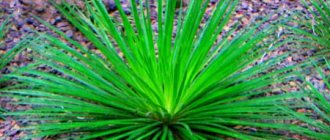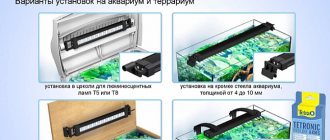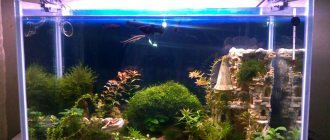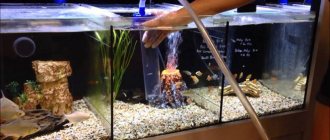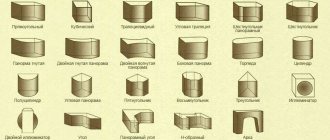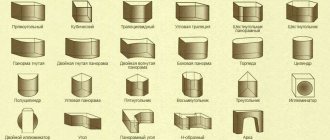I don’t do aquariums myself, but I have friends who build this beauty themselves and I very often communicate with them and see how and what they make aquariums from. This is a very painstaking and time-consuming matter, and the main thing in this matter is what kind of you choose for the aquarium
The fact is that many aquarists who initially started small aquariums eventually begin to think about how to get a larger aquarium for themselves.
Frankly speaking, this is a very correct decision, since the larger the aquarium, the easier it is to maintain, the more stable it “works” and naturally, you can get more fish for a larger volume, as well as more interesting fish than those kept in a small aquarium volume.
Therefore, if space allows, then after 20-50 liters of aquariums, the aquarist usually thinks about starting an aquarium with a volume of 200-250, or even 300 liters.
Therefore, the first question that arises is whether to buy or make an aquarium.
Of course, if your financial condition allows it, then it costs nothing to go and buy an aquarium in a store or order it from a master, but if, as they say, the budget is limited, then the time has come to pick up a tool and make an aquarium with your own hands.
Choosing the right glass for your aquarium.
That’s when the aquarist’s hard, harsh everyday life begins, in search of information about the upcoming project.
It goes without saying that in this process the experience that the aquarist has, what he has seen, what knowledge he has acquired from various sources, etc. plays an important role. as well as those around you who can share practical advice on the nuances of the process of gluing an aquarium.
But as a rule, the information received is very different.
Tables of aquarium parameters and glass sizes give average results, just like aquarium calculators on websites, and, as a rule, average data is entered into such tables. The experience of colleagues also plays a cruel joke, opinions are completely different: some focus on the strength of the product, others pay more attention to appearance, and still others to cheapness.
So where to choose the golden mean?
As you know, glass for an aquarium is 1/3 of the cost of an aquarium (approximately), so I don’t see any point in saving.
Glass for an aquarium is the most important element, on which 1/3 of all the characteristics of your product will depend (2/3 is glue, proportions, appearance and correct installation).
Let’s try to understand those nuances that are connected specifically with glass.
Well, first of all, we need to say that it is no secret that each glass has a thickness of: according to the standard for the CIS countries, it can be thickness: 1.0; 1.5; 2.0; 2.5; 3.0; 3.5; 4.0; 5.0; 6.0; 7.0; 8.0; 10.0; 12.0; 15.0; 19.0; 25.0.mm, the quality of glass varies from grade M0 to grade M7, it depends on the amount of defects that result from glass manufacturing.
When is it better to buy a ready-made option?
Nowadays, pet stores offer a huge selection of both standard rectangular and spherical aquariums, as well as other non-standard interesting shapes (concave, curved, elongated). And the fillers and unusual decorative details are simply eye-opening. In general, there will be no problems with the choice; it all depends on the tastes and finances of the buyer. And if you are purchasing a small aquarium for the first time, it is better to buy a ready-made one.
For gluing aquariums up to 300 liters, use the following glass thickness.
Glass for aquariums of various sizes.
- from 5-30l - 4 mm
- from 30-80l - 5 mm
- from 80-150l - 6 mm
- from 150-220l - 8 mm
- from 220-300l – 1 cm
All the stupidity of modern authors who write what why? After all, you can glue a 250 liter aquarium with stiffening ribs with 6 mm glass and it will stand perfectly and withstand loads, so why play it safe.
It’s all very simple, you’ve probably seen aquariums in pet stores produced by manufacturers who have been on the aquarium market for many years, have you seen at least one branded manufacturer have this web of glass ties at the top of the aquarium?
This is why it turns out that ties are only needed when the manufacturer has saved on thickness and is not confident either in the glass or in its work.
To say that you can save a lot by using 6 mm glass instead of 8 mm, no, at most you will overpay 1/3 of the cost of glass for an aquarium, and taking into account the fact that you are installing an aquarium for more than one year, then this overpayment is simply negligible for your calmness.
Also, when choosing the thickness of the glass, you need to take into account such important factors as the height of the aquarium and the quality of the glass.
Standard tables for calculating the thickness of glass for aquariums provide standard proportions for aquariums, but if your aquarium is disproportionate, say, very tall, or very narrow, or of irregular geometric shape, then this will immediately affect the thickness of the glass used.
Using used glass to make aquariums.
There is an opinion that if you take old window glass or display glass, you can make an aquarium out of it.
Never do this!
It’s all very simple, the fact is that, as a rule, old window and display glass was used with M3 glass according to the classification of glass, this meant that small sagging was allowed on the surface of such glass, the glass could have inclusions of air bubbles, and the surface of the glass had fat film.
Moreover, display windows were usually attached to frames made of metal corners, into which they were welded by electric welding. The inclusions from which fell on the surface of the glass, hardening to points that disrupted the structure of the glass.
When windows are used for a long time under different weather conditions, the glass also ages and crystallizes, which is reflected very noticeably in the future when cutting glass.
Therefore, if you have an idea to make yourself an aquarium from such glass, then it can be a maximum of a spawning tank, or a fish tank, up to 15 liters with glass at least 4 mm thick.
Table for calculating glass for an aquarium.
Plexiglas
Acrylic (and this is organic glass) has recently become very widespread in the manufacture of aquariums according to individual sketches. To obtain unusual shapes, simply bend it or place it in a heat chamber (200 degrees). A solvent is used for gluing, and the seams are completely transparent. The advantages of an acrylic aquarium are as follows:
- light weight, this is especially true with significant dimensions;
- plasticity, easily takes on any shape; the container turns out to be seamless;
- cutting glass to size is done quickly and effortlessly (especially important for additional ventilation holes).
But plasticity also has a second side - insufficient bending resistance. Because of this, the walls of the aquarium quickly deform (bend) under the influence of water pressure.
When cleaning, use only soft materials to avoid scratching. But the main disadvantage is the loss of transparency over time (guarantee - from 3 to 5 years).
Glass mode for aquarium.
This is probably one of the most important components. So to speak, the basis before sizing the aquarium.
It’s good if the aquarist knows how to cut glass efficiently himself, then he doesn’t need to explain the principles and the nuances that he needs to strive for.
If the cutting will be carried out in a glass workshop, then in order to avoid costs, both financial and nervous, I would recommend doing the following.
First of all, contact a glazier and ask him if he can cut your aquarium glass (of course, clarify that this must be done very precisely). Determine whether the workshop carries out such manipulations with glass as processing of ends, grinding, polishing, chamfering.
How to pay for materials and work performed, and in case of defects, whether the work will be redone and at whose expense.
If some omissions immediately arise or you see doubts from the master, since not all craftsmen cut aquariums, then you better take and do the following, do not skimp and order several glass blanks from the workshop measuring 20*20 cm and a thickness of 4 mm. After the squares are cut out, take them and place them on a flat surface on an edge, placing the flat side to each other, and look at how much the sides and corners match. After this, turn one of the squares 90* in a circle and apply it in the same way, again looking at how much the corners meet and whether the glass is cut evenly.
This way you will see how responsibly and skillfully the master approached the work and whether he can be trusted to cut glass for a large aquarium.
If you are satisfied with the quality of the work, then you next need to draw up a drawing of the glass that you will cut.
ATTENTION! An accurate drawing in 2 copies is a guarantee of the accuracy of the work.
The only point that needs to be taken into account is what you are going to measure with; for such purposes, it is advisable to purchase a tape measure that complies with GOST, otherwise the difference between your size and the cut glass in the workshop can be up to 2 mm.
The drawing can be drawn manually or using various programs, of which there are a lot today on the Internet, they are called aquarium calculators.
When using such a program, you should pay attention that the program sometimes includes such options as the thickness of the adhesive seam, as well as the presence of a second bottom, stiffener ties. In accordance with your sketch, decide whether you will use the nuances proposed by the program.
This will determine both the size of the glass cut out and their quantity, which will ultimately all affect the cost.
Another not unimportant point.
How to make a bottom
The bottom of the aquarium can be glued to the walls in two ways:
- walls surround the edges of the bottom. Here we use the bottom as a basis for all stages of frame assembly;
- the walls are placed on the surface itself. To achieve this result, we begin to glue the walls together, and then turn the frame over with the bottom up. We put the bottom of the aquarium there, having previously smeared the edges of the walls with glue.
Large aquariums from 200 liters have a double bottom, which is made of two sheets of glass. These sheets are tightly connected over the entire area using glue, enhancing overall strength and increasing load carrying capacity.
Tips from the professionals
- When assembling the structure, do not forget to install stiffeners - narrow glass strips that are attached to the inside along the longitudinally upper edge of the walls. These ribs strengthen the body from above, and subsequently a lid can be placed on them;
- To glue the sheets of the aquarium, start from the front wall + bottom and end with the back wall. This technique is relevant if you have chosen the method of decorating the walls outside the edges of the bottom;
- Be sure to place wooden blocks under the clamps to avoid damaging the glass with metal elements;
- If you think that the aquarium has leaked, do not rush to create panic and look for cracks. Perhaps it is just condensation that accumulates on the lamp and then flows onto the outer surface of the aquarium.
Now you know how to make an aquarium with your own hands simply and efficiently. In general, the procedure is simple, especially when installing small models. It is enough to have patience and a little accuracy to get the desired result.
How to buy an inexpensive aquarium in an online store: market overview
| Manufacturer/Model | Volume, l | Dimensions, mm | Glass thickness, mm | price, rub. | Notes |
| Biodesign/Q-Scape | 6,5 | 190 x 190 x 230 | 4 | 890-950 | Backlight is not included as standard. |
| Biodesign Q-Scape | |||||
| Tetra/ Betta Bowl | 1,8 | — | — | 1500-1620 | Miniature model with built-in LED lighting. |
| Tetra Betta Bowl | |||||
| Biodesign/Classic 30 | 27 | 400 x 200 x 340 | 4 | 2200-2580 | The buyer can choose the color design of the plastic parts. |
| Biodesign Classic 30 | |||||
| Aquarius | 60 | 600 x 250 x 46 | 6 | 3480-3930 | A lamp is installed in the cover of the structure. |
| Aquarius Aquarium | |||||
| Aquael/LEDDY 80 | 105 | 750 x 350 x 400 | — | 7200-7650 | The kit includes: filter, lighting, heating element, hole for feeding fish. |
| aquarium Aquael LEDDY 80 | |||||
| Biodesign/ Diarama 150 | 100 | 850 x 600 x 520 | 6 | 12400-13400 | Corner model with cabinet. |
| aquarium Biodesign Diarama 150 | |||||
aquarium Biodesign Diarama 150
For your information! When studying the market, you can find out that the price of a 100 liter aquarium is not excessive. When comparing different models, pay attention to the composition of the set. If necessary, you need to purchase a compressor and other system components.
Stiffeners and ties
Stiffening ribs and ties for frameless aquariums are strips of glass that are designed to relieve stress from the front and rear glass of the aquarium, remove its deflection and thereby increase its strength. The need to use ribs and ties is influenced more by the length of the aquarium than by its height. This structural element should not be neglected, because it greatly increases the strength of your jar.
Stiffening ribs are long strips of glass glued to the front and rear glass at their ends. The ties are placed across the aquarium and glued flat to the opposite stiffeners.
The glass thickness for the fins and tie rods is usually the same as for the rest of the aquarium walls. In addition to being a structural element, the stiffeners also have a practical benefit: they are an ideal support for a cover glass.
Some fans of open aquariums with a hanging lamp use the technology of making jars without the use of stiffeners and ties; this technology limits the ratio of the length to the width of the aquarium, and also requires the use of higher quality and thicker glass. Due to the labor intensity, high accuracy of calculations and high cost, we will not consider it.
Source
